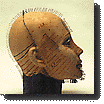

 Monika |
Monika tackles sick-building syndrome A tall, blue-eyed robot named Monika is the most unusual partner in UC Berkeley's new center to study the work environment. Loaded with sensors from head to toe, Monika's mission is to masquerade as an office worker and report on what working conditions in commercial buildings are really like. With the use of Monika and other sophisticated instrumentation, researchers at the Center for the Built Environment will investigate how to make office workers most comfortable and productive. "Buildings are designed and built and then there is no feedback on how well they are working," says Edward Arens, professor of architecture and director of the center. To understand what makes workers comfortable indoors, Arens and his colleagues, drawn from epidemiology, real estate finance, engineering, and architecture, need data. Enter Monika and her assorted kin. Imported from Denmark, Monika looks like a store mannequin but is packed with wires and computer circuitry that respond to changes in the environment. Custom-made and expensive, there are only a few such robots in the U.S. Environmental conditions to be studied include temperature, humidity, sound and light levels, energy conservation, air quality and pollution, and sick-building syndrome. Workers in buildings with sealed windows, for instance, complain of sick-building syndrome at twice the rate of those with windows that open and close. "This could be air-quality related, or it could be partly psychological, with people feeling less control over their environment," says Arens. The researchers have studied building quality worldwide.
"If they are air-conditioned buildings, their problems are the same
everywhere," says Arens. "It's too cold in summer, too hot in
winter, and there's often not enough air flow." [Table of Contents] [Berkeley Magazine Home] [UC Berkeley Home] Please e-mail your comments to ucbwww@pa.urel.berkeley.edu |